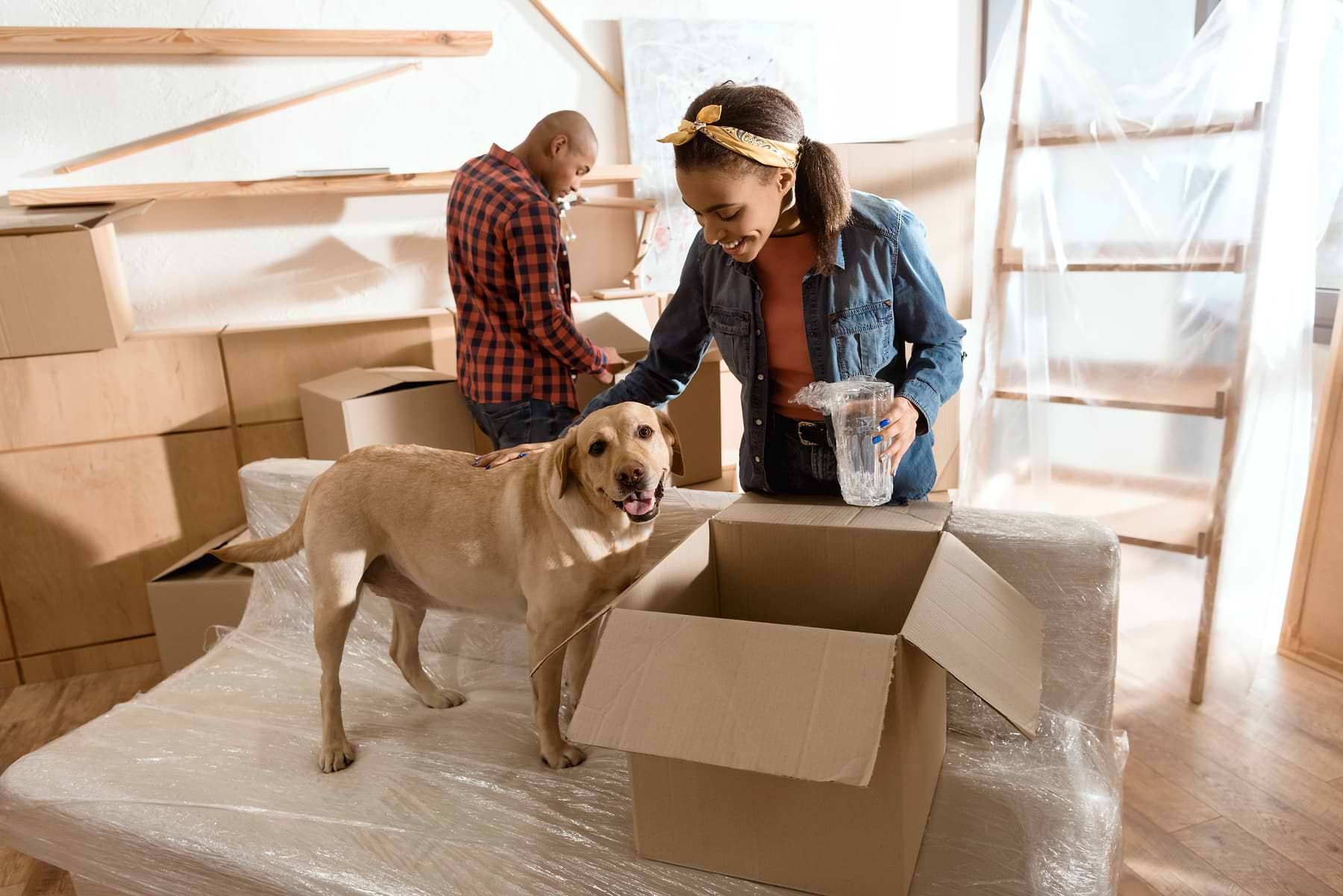Bringing home a new dog is as exciting as it is nerve-wracking. If it feels that way for you, just imagine how your doggy is feeling! It is always best to be prepared for a homecoming or a moving day, so here is our guide on how to help your dog adjust to their new home and keep yourself stress-free.
Give Them Their Own Space To Decompress
Crates are always a helpful tool for dogs, as they inspire natural denning instincts and create an automatic safe place. However, this principle is perhaps never more true than it is with dogs who are moving in with a new family for the first time. During this time of heavy change, your new best friend is going to need something reliable, steady, and comfortable that they can come back to. This is exactly where crates come in.
Have your crate and dog bed set up as soon as they enter your house or room so that they will know it is a constant presence. Feel free to feed them some meals there, offer them treats to enjoy, or cuddle with them near their crate or bed. Either of these methods of positive reinforcement will show your dog that this is a pleasant space for them to spend time.
To make the new space even more enticing, you can spruce it up with comfortable padding, blankets, toys, or anything else they would like. Once your dog has become more comfortable with their new environment, you can even begin the process of crate training.
Start Small, Then Work Up
The best way to introduce a dog to a new house is to do so slowly. As you will find out from the rest of this article, slow and steady definitely win the race when it comes to a new dog. At first, let your dog perhaps just explore one room of your house. Set them up with all of their essentials in that room. Their food and water bowls should be easily accessible and within eyeshot at all times.
This room should also include your dog’s crate. Setting them up with this safe place where they can feel totally comfortable is crucial. They can start just exploring their crate, and as they feel more comfortable, they can begin to branch out. Make sure that anything that is not dog-friendly has been removed from the room before they arrive (we will touch on setting up or unpacking more later).
Your dog’s crate should be set up in whatever room of the house they will be spending the most time in. For instance, if you want your dog to become particularly comfortable in your bedroom, then you should place their crate there. Afterward, it is best to leave their crate in that first spot for as long as possible. This will establish a sense of trust, as well as the feeling that their safe space will always be right there when they need it for peace of mind.
Once your dog feels comfortable and confident in their new surroundings, you can start to introduce them to different rooms one by one. Remember to do this process slowly, as creating positive associations early on will help them significantly.
Form a Routine and Do Not Stray From It
Dogs are creatures of routine, first and foremost. This means that they crave structure, and feel much more comfortable when it is provided. Our dogs appreciate knowing what to expect and when, so it is best to offer them this comfort as soon as possible.
You can start laying down some ground rules and a sense of routine nearly immediately after your dog has been brought home. Do not overwhelm them during this time, as they are already trying to learn the lay of the land. However, gently guiding them into a routine will help them get eased in.
Find out when your dog was fed prior to you bringing them home that day, and you can use that information to inform when you feed them next. It should be roughly the same time that you intend to feed them daily, but make sure not to overfeed or wait too long in between meals. Then, you can also take your new pet on daily walks for mental stimulation, exercise, and potty breaks at the same times you are planning to.
Feed Them the Same Food and Switch Gradually
Before taking your dog to their new home for the first time, there are multiple pieces of information that you should have at your disposal. First, ensure that you have any and all of your dog’s medical records up until this point. These will be necessary for your dog’s vet to see in order to provide them with the best possible care.
Learn if your dog has a preferred playtime activity, if they have any favorite toys, or if they have any triggers that make them feel particularly stressed out. Lastly, make it a point to find out what kind of dog food they were fed, and have that same variety at the ready.
By no means do you have to keep your dog on this food forever, but you should start them out on it right after moving home with you. This will help to avoid undue stress as your pet’s whole world is changing, but the benefits do not stop there. A sudden shift in diet can cause digestive distress even with well-adjusted pets, so you should instead shift your pet to any new foods gradually.
Ideally, this process should take a week or two. Yet again, slow and steady wins the race. If your dog is overly stressed, or if you notice any digestive problems occurring, do not hesitate to slow the process down to a couple of weeks or more.
Have Your Home Set Up Ahead of Time
As we have established previously, dogs love to stick to a routine. As a direct result of this trait, change is often seen as intimidating and as a cause for fear. So much is already changing for your new pet, so do all you can to keep the changes after moving in to a minimum. Rather than bringing your dog home for the first time without everything being prepared for their arrival, take the time to set up everything that they need beforehand.
Put your dog’s crate in your room so that they can stay with you, adjust slowly, and avoid developing symptoms of separation anxiety. Have their food (the same food that they were previously fed) and water ready, and make sure that they always have their necessities available. Get any dog toys as well as an ID tag (with information such as your phone number), collar, and leash before coming home, so that they can immediately become a part of your pet’s new routine.
Make all of the necessary preparations so that your dog can settle in as easily as possible. This way, you can spend the majority of your time focusing on your dog themselves, as well as building a strong bond together.
Introduce People One by One
This next suggestion is somewhat similar to only showing your dog a single room at a time. We want to avoid overstimulating our dogs, so it is important to introduce them to only a small number of people. One or two is best at the very beginning. This allows you to create trust together, which will be the foundation upon which everything else is built.
Once your dog seems fairly at ease with you, you can start considering how to introduce them to someone new. The first few days or possibly even weeks are not the time to introduce them to just any old acquaintance. Instead, use this time to get your furry friend familiar with people that they will be seeing all the time. For example, any roommates or family members should be slowly introduced to your pet during this time.
An excellent way that pet parents like to ease their dogs into meeting new people or other animals is to do so on neutral ground. Taking a walk is likely a fun activity for your dog, and it is also one where there are different sights and smells in their new neighborhood to enjoy. Bringing someone to meet your dog during a walk is perfect because it immediately starts this stranger off with a positive association.
Get To Know Your Dog’s Signals
As pet parents, it is our duty to learn how to speak our dog’s language. Although we might not start barking back at them anytime soon, our pets do have ways of communicating how they are feeling. Get to know how your dog acts when they are happy. Similarly, learn how they are when they are overexcited, scared, or even aggressive.
Knowing how to read your dog is critical to being able to create more trust and take them out of possibly stressful situations. This will come with both time and observation. As you see your dog react to more and more circumstances, you will inevitably learn how they tend to act, and what positive behavior looks like for them.
Patience Is Always Key
Whether you are bringing home a new puppy, a rescue dog, or any other kind of pooch, there are ways to assuage your dog’s anxiety and avoid a lot of stress. By being patient and understanding what your dog is trying to tell you, your furry friend should be settling into their new space before you know it.
Sources:
How To Switch Dog Foods: Transitioning Your Dog’s Diet | American Kennel Club
How To Help an Adult Dog Adjust to a New Home | American Kennel Club

The Diggs Team
We believe our dogs deserve safer, better designed pet products.
You might also like
Crate training tips, stories and inspiration
View all blogsIn Your Diggs
Share your photos with #DiggsPet and tag us @DiggsPet on IG and TikTok.



